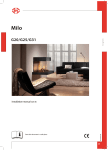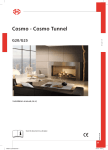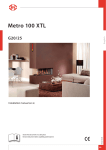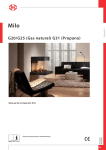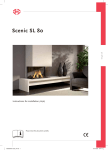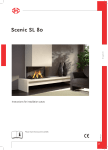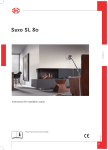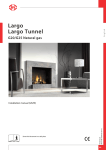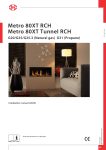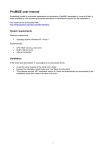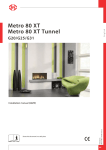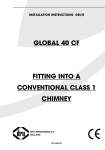Download G20/G25/G31 - The Gas Company
Transcript
Milo English G20/G25/G31 Installation manual (GB / IE) 959.028.01.GB Store this document in a safe place GB 95902801_GB Install.indd 1 12-7-10 11:2 M I LO - I N S TA L L AT I O N M A N UA L Contents English Preface 1. Introduction 2. CE declaration 3. SAFETY 3.1 General 3.2 Regulations 3.3 Precautions / safety instructions during installation 4. Instructions 5. Removing the packaging 6. Installation 6.1 Regulations 6.2 Type of gas 6.3 Gas connection 6.4 Placing the appliance 6.5 Flue gas discharge / combustion air supply system 6.6 Placing the chimney breast 6.7 Connecting gas 6.8 Adjusting the appliance 6.9 Placing the wood set 6.10 Glass panes 6.11 Finishing the appliance 7. Wireless remote control 7.1 Receiver 8. Final check 8.1 Gastightness 8.2 Gas pressure / line-pressure 8.3 Ignition pilot burner and main burners 8.4 Flame image 9. Maintenance 9.1 Parts 10. Delivery 11. Malfunctions Appendix 1 Parts included with the delivery Appendix 2 Technical data Appendix 3 Figures Appendix 4 Figures page 3 3 4 4 5 5 5 6 6 6 6 6 6 6 6 12 13 13 14 15 16 17 17 17 17 17 17 18 18 19 19 19 23 23 24 36 GB 2 95902801_GB Install.indd 2 12-7-10 11:2 M I LO - I N S TA L L AT I O N M A N UA L Preface English DRU, a manufacturer of gas-fired heating appliances, develops and produces products that comply with the highest quality, performance and safety requirements. This guarantees that the user will be able to enjoy using his product for many years to come. This appliance has a CE marking, which means that it complies with the essential requirements of the European gas appliance directive. Two manuals are supplied with the appliance: the installation manual and the user manual. As an installer, you must be competent in the field of atmospheric gas-fired heating. The installation manual will give you the information you need to install the appliance in such a way that it will operate properly and safely. This manual discusses the installation of the appliance and the regulations that apply to the installation. In addition, you will find technical data for the appliance and information on maintenance, any malfunctions that might occur and their possible causes. The figures are included at the back of this booklet (Appendix 3). Please carefully read and use this installation manual. The following symbols are used in the manual to indicate important information: ➠ Work to be performed !Tip Suggestions and recommendations !Caution You will need these instructions to prevent problems that might occur during installation and/or use. Caution You need these instructions to prevent fire, personal injury or other serious damages. After delivery, you should give the user manual and this installation manual to the user. 1. Introduction Milo is a suspended atmospheric gas-fired heating appliance. It is fixed to the wall by means of a supplied wall bracket. In order to support it, the appliance is standing on 2 adjustable legs at the rear. The safe operation of the appliance is guaranteed by the use of a second thermocouple fitted to one of the main burners. Milo is a room-sealed appliance. A room-sealed appliance does not extract the combustion air from the living environment, but from outside. This is done by means of a combined flue gas discharge system / combustion air supply system. In this concentric system, the outer pipe functions as the air supply and the inner pipe functions as the flue gas discharge. Milo has a rectangular (flat), concentric flue spigot. Both a rectangular and round concentric system can be connected to this. DRU has a number of adapters in its range for the transition from rectangular to round. The concentric flue gas discharge / combustion air supply system can be installed through the wall or through the roof. Milo was designed to suspend freely. The narrow chimney breast at the rear of the appliance is only intended to hide the flue gas discharge / combustion air supply system and the adjustable legs. Construction in a standard chimney breast, the construction chimney breast, is allowed. In that case, a mantel iron must be placed, in order to avoid that the appliance is burdened by the weight of the construction chimney breast. DRU is able to supply a mantel iron. Also make sure that the gas control and receiver, which are below the appliance, can still be reached after placing the construction chimney breast. The chimney breast may only be made of plate material. In order to reach a proper heat discharge, the chimney breast must be ventilated at both sides, and an air supply must be made at the bottom. DRU has various ventilation elements in its program; the lux fino elements can be specially supplied for the narrow chimney breast. A base (platform) will be placed around the appliance. The choice of a natural stone or lacquered steel version was made during purchase. The construction of the appliance was based on the weight of the DRU base. If you want to extend the base supplied by DRU, you will need an additional bearing construction. The appliances are supplied with a wireless remote control that works on batteries. 3 GB 95902801_GB Install.indd 3 12-7-10 11:2 M I LO - I N S TA L L AT I O N M A N UA L 2. CE declaration English We hereby declare that the design and construction of DRU’s atmospheric gas-fired heating appliance comply with the essential requirements of the Gas Appliance Directive. Product: atmospheric gas-fired heating appliance Type: Milo Applicable EEC directives: 2009/142/EC Applied harmonized standards: NEN-EN-613 NEN-EN-613/A1 Internal measures by the company guarantee that appliances produced in series comply with the essential requirements of the prevailing EEC directives and the standards derived from them. This declaration will lose its validity if adjustments are made to the appliance, without prior written permission by DRU. M.J.M. Gelten General manager DRU verwarming B.V. Postbus 1021, 6920 BA Duiven Ratio 8, 6921 RW Duiven www.dru.nl 3. SAFETY Caution - Carefully read this chapter on safety, before you start performing installation or maintenance work; - Please observe the general regulations and the precautions/safety instructions in this manual. 3.1 General 3.2 Regulations Please install the appliance in accordance with the applicable national, local and constructional (installation) regulations. 3.3 Precautions / safety instructions during installation Carefully observe the following precautions/safety regulations: ➠ ➠ ➠ ➠ ➠ ➠ ➠ ➠ ➠ ➠ ➠ ➠ ➠ ➠ ➠ ➠ ➠ ➠ ➠ ➠ ➠ ➠ you should only install and maintain the appliance if you are a competent installer in the field of atmospheric gas-fired heating; do not make any changes to the appliance; use solid, non combustible and heat-resistant materials for the wall from which the appliance will be suspended; always use the adjustable legs to support the appliance; use non combustible and heat-resistant plate material for the chimney breast, including the top of the chimney breast and the material in the chimney breast; take sufficient measures to prevent temperatures of a wall behind the chimney breast becoming too high, including the materials and/or objects behind the wall; ventilate the chimney breast at both sides by means of the ventilation holes, which will form a combined passage of at least 200 cm2; attach an additional air supply at the bottom of the chimney breast; in case of a narrow chimney breast, maintain a tolerance of approx. 2 mm between plate material and construction frame; comply with the minimum required internal measurements, in case of a construction chimney breast; comply with the minimum required free space of 500 mm at both sides of the appliance, as well as above the appliance, because of the heat emission of the appliance; only use the flue gas discharge / combustion air supply system supplied by DRU; mount the appliance using the wall bracket supplied; do not suspend the appliance too close to the wall; this is prevented by using the spacer brackets; do not cover the appliance and/or do not wrap it in an insulation blanket or any other material; make sure that combustible objects and/or materials have a distance from the appliance of at least 500 mm only ever use the supplied wood set; place the wood set exactly as described; make sure the pilot burner and the space around it is kept free; make sure thermocouple 2 and the space around it are kept free; make sure there is no dirt in gas pipes and connections; place a gas tap near the appliance; GB 4 95902801_GB Install.indd 4 12-7-10 11:24 M I LO - I N S TA L L AT I O N M A N UA L ➠ ➠ ➠ ➠ ➠ ➠ ➠ 4. check the connections for gastightness before using the appliance; use heat resistant electrical wiring; place the electrical wiring in such a way that they are free from the appliance; replace torn or broken glass panes; avoid blocking of the pressure equalization hatch(es) on top of the appliance; check whether the pressure equalization hatch(es) fit well onto the sealing surface, prior to building in the appliance; do not ignite the appliance until it is fully installed. Instructions ➠ ➠ ➠ ➠ ➠ ➠ 5. English Observe the following items during installation in order to guarantee a proper and safe operation of the appliance: ➠ place the spacer brackets in correspondence with the construction depth of the appliance. The construction depth depends on whether a rectangular or round flue gas discharge / combustion air supply system was chosen. During manufacturing, the spacer brackets are placed for application of a rectangular system; avoid that the ignition cable runs over the receiver; avoid that the ignition cable touches or crosses the antenna; avoid that the ignition cable runs alongside metal parts, in order to prevent weakening of the spark; avoid damaging the glass panes when removing/placing them; clean the glass panes before you use the appliance, in order to prevent dirt from burning in the glass; make sure that the wires of thermocouple 2 cannot come into contact with hot parts. Removing the packaging Note the following items when removing the packaging: ➠ ➠ Check the appliance for damages during transport. If necessary, contact DRU Service. !Caution Avoid damaging the front glass pane when removing it from the packaging. After removing the packaging, you should have the following components: - Socket spanner; you will find it in the space between the assembly frame and the combustion chamber; - Decorative strips; you will find them in the abovementioned space as well; - Front glass pane; you will find it in the same box as the appliance – provided with protective corners; - Box containing parts; you will find it in the combustion chamber; - Inner frame; consisting of a lacquered steel frame or a four part set of natural stone; - Base; made of lacquered steel or natural stone; - Top; intended for the top of the appliance. ➠ Remove the box containing parts from the combustion chamber. In appendix 1 / table 5 you can see which parts you should have after removing the packaging. ➠ ➠ Contact DRU Service if you do not have all the parts after you finished removing the packaging. Dispose packaging in accordance with local regulations. 5 GB 95902801_GB Install.indd 5 12-7-10 11:24 M I LO - I N S TA L L AT I O N M A N UA L 6. Installation Read this manual carefully to ensure a proper and safe operation of the appliance. !Caution Install the appliance in the order described in this chapter. 6.1 Regulations ➠ ➠ Observe the applicable (installation) regulations. Observe the regulations/instructions in this manual. 6.2 Type of gas English The data plate indicates for which type of gas, gas pressure and for which country this appliance is intended. The data plate is connected to a chain. It should remain connected to the chain. Caution Check whether the appliance is suitable for the type of gas and the gas pressure used at the location. 6.3 Gas connection Place a gas tap in the gas connection, close to the appliance. Caution Make sure there is no dirt in gas pipes and connections. The following requirements apply to the gas connection: - use a gas pipe with the correct dimensions, so that no pressure loss can occur; - the gas tap should have the CE marking; - you should always be able to reach the gas tap. 6.4 Placing the appliance Caution - Attach the appliance to a wall of solid, non combustible and heat-resistant material; Always use the adjustable legs to support the appliance; Take sufficient measures to prevent temperatures of a wall behind the chimney breast becoming too high, including the materials and/or objects behind the wall; Comply with the minimum required free space of 500 mm at both sides of the appliance, as well as above the appliance, because of the heat emission of the appliance; Make sure that combustible objects and/or materials have a distance from the appliance of at least 500 mm; Do not suspend the appliance too close to the wall; this is prevented by using the spacer brackets Level the appliance horizontally and vertically, using the adjustable feet and adjustment bolts; Do not cover the appliance and/or do not wrap it in an insulation blanket or any other material; Do not make any changes to the appliance. !Caution - Take the adjustable height of the appliance into account. It depends on the setting of the adjustable legs: minimum 250 and maximum 500 mm (see fig. 1); Take the minimum internal depth of the appliance into account (see fig. 1). ➠ !Tip During manufacture, the spacer brackets on the appliance are mounted for the application of the rectangular flue gas discharge / combustion air supply system. Place the appliance as follows: ➠ ➠ ➠ ➠ ➠ ➠ ➠ Determine the location of the appliance. Determine the suspension height of the appliance; see fig. 1; Provide a gas connection at the location. For details, see section 6.3. Determine whether a rectangular or round flue gas discharge / combustion air supply system will be connected to the appliance’s flue spigot; see fig. 1. Make a passage for the flue gas discharge/combustion air supply system with the following diameters. For details, see section 6.5: - Ø 160 mm for a wall terminal through non combustible material; - Ø 250 mm for a wall terminal through combustible material; - Ø 160 mm for a roof terminal through non combustible material; - Ø 250 mm for a roof terminal through combustible material. Place the appliance on its destined location. When leading the rectangular flue gas discharge / combustion air supply system through a floor and/or ceiling, take the following dimensions into account; for details see section 6.5: GB 6 95902801_GB Install.indd 6 12-7-10 11:24 M I LO - I N S TA L L AT I O N M A N UA L ➠ ➠ ➠ ➠ ➠ ➠ - 350x140 mm through non combustible material; - 430x220 mm through combustible material. Check whether the position of the spacer brackets on the appliance is suitable for the chosen rectangular (A) or round(B) flue gas discharge / combustion air supply system; see fig. 2. Loosen the screws of the spacer brackets (C) and turn the brackets around when a round system is used; see fig. 2. Mount the appliance using the wall bracket and the key bolts supplied. Extend both adjustable legs and secure them with a self-tapping screw. Use the feet of the adjustable legs to level the appliance horizontally; see fig. 1, arrow 1. Use the adjustment bolts to level the appliance vertically; see fig. 1, arrow 2. English 6.5 Flue gas discharge / combustion air supply system 6.5.1 General The appliance is of the C11/C31 type. The appliance is connected to a combined flue gas discharge/combustion air supply system, hereafter referred to as the concentric system. The flue spigot of the appliance, is a rectangular, concentric version. To this you can connect a rectangular (A) (310x100 / 205x55 mm) and/or round (B) (Ø100 / Ø150 mm) concentric system; see fig. 3a. The passage to the outside can be made with a wall terminal (see section 6.5.2) or a roof terminal (see section 6.5.3). If necessary, you can also use an existing chimney (see section 6.5.4). Caution - Only use the rectangular and/or round concentric system supplied by DRU. This system has been tested together with the appliance. DRU cannot guarantee a proper and safe operation of other systems and does not accept any liability for this (see appendix 4); - Always use coupling pieces with corresponding seals for the connections in the rectangular system. These are supplied with the system; see the accompanying instructions; - Secure the coupling pieces with the self-tapping screws supplied; - For connecting to an existing chimney you should only use the chimney kit supplied by DRU. The concentric system is constructed from (flue spigot of ) the appliance. If structural circumstances require that the concentric system is placed first, the appliance can later be connected with a telescopic pipe piece, provided a round concentric system is used. In that case, an adapter to round must first be placed on the flue spigot. It is not possible to supply a telescopic pipe piece for a rectangular concentric system. 6.5.2 Application with wall terminal The wall terminal is a round concentric system. 6.5.2.1 Construction of concentric system with wall terminal !Caution - When using rectangular pipes it is only possible to end in the wall from which the appliance is suspended (there is no bend available for the concentric system); - When the pipes end at right angles in the appliance, you can start with rectangular pipes, but you must change over to the round system. The concentric system with wall terminal has to comply with the following conditions: - First, a concentric pipe of at least 1 meter should be connected vertically to the appliance; - The total vertical pipe length may have a maximum of 4 meters; - After the vertical part, a 90º bend (round system) or a squared adapter (rectangular system) is connected; - When using a minimum of 1 meter up to a maximum of 4 meters of vertical pipe length, the total horizontal pipe length can have a maximum of 3 meters (excluding wall terminal, see fig. 3b and fig. 3c). Depending on the construction of the concentric system, the appliance must receive further settings by removing the air inlet guide and the injector screens; see Table 1 for determining the conditions and section 6.8, Adjusting the appliance, for the method. 7 GB 95902801_GB Install.indd 7 12-7-10 11:24 M I LO - I N S TA L L AT I O N M A N UA L Table 1: Conditions for the adjustment of the appliance with a wall terminal G20/G25/G31 Total number of meters vertical pipe length See figure Total number of meters horizontal pipe length (excluding wall terminal) Air inlet guide Injector Baffle screens** Distance of restriction in mm 1-4 >0 - 3 3b NO NO NO OPEN 1-4 0* 3c YES YES NO OPEN English * factory setting ** not valid for G31 6.5.2.2 Placing concentric system with wall terminal Caution - Maintain a distance of at least 50 mm between the outside of the concentric system and the walls, when using a round system; - Maintain a distance of at least 23 mm between the outside of the concentric system and the walls, when using a rectangular system; this distance is fixed due to the construction of the rectangular system; - Maintain a distance of at least 50 mm between the outside of the concentric system and the ceiling; - Use non combustible material for building the concentric in, for instance, a cove; - Use heat-resistant insulation material when passing through combustible material; - The rosette (mounting inner plate) of the wall terminal is too small to seal the Ø 250 mm opening when passing through combustible material. That is why you should first apply a sufficiently large heat-resistant intermediate plate to the wall. Then, the rosette is mounted on the intermediate plate. !Caution - When using rectangular pipes it is only possible to end in the wall from which the appliance is suspended (there is no bend available for the concentric system); - When the pipes end at right angles in the appliance, you can start with rectangular pipes, but you must change over to the round system; - Some heat-resistant insulation materials contain volatile components that will spread an unpleasant smell for a prolonged time; these are not suitable. Place the concentric system as follows: ➠ ➠ ➠ Build the system up from (the flue spigot of) the appliance. Connect the concentric pipe pieces, the adapter and, if necessary, the bend. In case of the rectangular system, you must first attach a coupling piece on each connection, as described below (see fig. 3d): !Caution In case of rectangular pipe pieces, the internal pipe is longer at the bottom than the external pipe; the internal pipe glides in the internal pipe of the flue spigot or the previous pipe piece; - For reducing a rectangular pipe piece, unscrew the internal pipe from the external pipe; - Make the internal pipe and external pipe equally long at the top end; - Retighten the internal pipe; - Place the coupling piece plus seal on the reduced pipe piece and fix it at both front sides by means of 2 self-drilling screws. - Place a red seal on the flue spigot of the appliance; - Then, place the coupling piece on the flue spigot; - Secure the coupling peace at both front sides using 2 self-tapping screws; - Place a red seal on the coupling piece; - Then place a rectangular pipe piece or an adapter to round; - Secure the rectangular pipe piece or adapter at both front sides using 2 self-tapping screws; - At each next rectangular pipe piece or at the adapter, place the spacer brackets on the pipe at the same height as the coupling piece; - Secure the spacer brackets to the wall, so that the weight of the pipes does not rest on the appliance. Attach the first round concentric pipe piece to the adapter using 4 self-drilling screws. ➠ On this connection, apply a clip binding with silicon sealing ring. ➠ In case of round pipe pieces, attach a clip binding with silicon sealing ring to each connection. ➠ Use a self-tapping screw to fix the clip binding to the pipe on locations that cannot be reached after installation. ➠ In case of round pipes, apply sufficient brackets, so that the weight of the pipes does not rest on the appliance. ➠ Determine the remaining length of the wall terminal; ➠ Make sure the wall terminal has the right dimensions. ➠ GB 8 95902801_GB Install.indd 8 12-7-10 11:24 M I LO - I N S TA L L AT I O N M A N UA L !Caution - Make sure that the right insertion length is maintained; - Place the wall terminal with the groove/folded seam at the top; - Make sure the horizontal concentric pipe pieces are sloping towards the wall terminal, in order to prevent rain water from entering. ➠ ➠ Mount the rosette (mounting inner plate); if necessary, on a heat resistant intermediate plate when passing through combustible material. Attach the wall terminal from the outside with four screws in their respective holes. 6.5.3 Application with roof terminal English The roof terminal is a round concentric system. 6.5.3.1 Construction of concentric system with roof terminal The concentric system with roof terminal has to comply with the following conditions: - The construction of the chosen system has to be allowed. (See the procedure described below); - First, a concentric pipe of at least 1 meter should be connected vertically to the appliance. Depending on the construction of the concentric system, the appliance is set by: - placing the baffle; - removing the air inlet guide or placing the additional air inlet guide; - Removing the injector screens. In the following procedure you can see how the allowability of a concentric system can be determined and which settings are needed. ➠ Determine the following data: 1) The number of bends required (no distinction is made between 45° and 90° bends); 2) The total number of meters of horizontal pipe length; 3) The total number of meters of vertical and/or sloping pipe length (roof terminal excluded). With these data and Table 2 you will be able to determine whether the concentric system is allowed. In Table 3 you can see which setting the appliance requires. Follow the procedure described below: ➠ ➠ In the first 2 columns of Table 2, look for the number of bends required and the total horizontal pipe length. In the 3rd column of Table 2, look for the total vertical and/or sloping pipe length. ➠ Use Table 3 to determine which conditions apply for the baffle, the air inlet guide and the injector screens (for setting, see section 6.8). If you end up in a box with the letter A, B, C, D or E the concentric system chosen by you is allowed. Examples To clarify, we will give 2 examples to determine the allowability of a concentric system and the conditions for setting the appliance. In Table 2 the route to be followed is indicated by arrows. The result is indicated by a box with a red border. Example 1 1) 2 bends 2) 3 meters horizontal 3) 8 meters vertical/sloping → Construction of this concentric system is allowed. → Situation C applies for the adjustment of the appliance. Example 2 1) 3 bends 2) 4 meters horizontal 3) 9 meters vertical/sloping → Construction of this concentric system is not allowed. 9 GB 95902801_GB Install.indd 9 12-7-10 11:24 M I LO - I N S TA L L AT I O N M A N UA L Table 2: Determination of the permissibility of a concentric system with a roof terminal G20/G25/G31 Total number of meters horizontal pipe length Total number of meters vertical and/or sloping pipe length 1 2 3 4 5 6 7 ↓8 ↓9 10 11 12 no bends 0 B C C D D E E E E E E E 2 bends 0 A A B C C D D E E E E E A A B C C D D E E E A B C C D D E A A B C C D A A B C 1 2 English → A 3 4 5 3 bends 0 A 1 A A B C C D D E E E A A A B C C D D E E A A A B C C D D A A A B C C A A A B A B C C D D E E A A A B C C D D E A A A A B C C D A A A A B C A A A A 2 3 → 4 E 5 4 bends 0 A A 1 A 2 3 A 4 E 5 5 bends - ■ = situation is not allowed Tabel 3: Voorwaarden voor afstellen van het toestel bij toepassing van een dakdoorvoer G20/G25/G31 Situation Air inlet guide Injector screens* Baffle Distance of restriction in mm A N0 N0 N0 OPEN B ADDITIONAL YES YES 30 C ADDITIONAL YES YES 24 D ADDITIONAL YES YES 19 E ADDITIONAL YES YES 15 ■ = situation is not allowed 6.5.3.2 Placing concentric system with roof terminal The roof terminal can end in a sloping and a flat roof. The roof terminal can be supplied with an adhesive plate for a flat roof or with a universally adjustable tile for a sloping roof. In case of a sloping roof with a slope up to 24°, it is also necessary to use an adhesive plate. Caution - Maintain a distance of at least 50 mm between the outside of the concentric system and the walls, when using a round system; - Maintain a distance of at least 23 mm between the outside of the concentric system and the walls, when using a rectangular system; this distance is fixed due to the construction of the rectangular system; - Maintain a distance of at least 50 mm between the outside of the concentric system and the ceiling; - Use non combustible material for building the concentric in, for instance, a cove; - Use heat-resistant insulation material when passing through combustible material. !Caution Some heat-resistant insulation materials contain volatile components that will spread an unpleasant smell for a prolonged time; these are not suitable. GB 1 0 95902801_GB Install.indd 10 12-7-10 11:24 M I LO - I N S TA L L AT I O N M A N UA L Place the concentric system as follows: ➠ ➠ ➠ Build the system up from (the flue spigot of) the appliance. Connect the concentric pipe pieces, the adapter and, if necessary, the bends. In case of the rectangular system, you must first attach a coupling piece on each connection, as described below (see fig. 3d): !Caution In case of rectangular pipe pieces, the internal pipe is longer at the bottom than the external pipe; the internal pipe glides in the internal pipe of the flue spigot or the previous pipe piece; - ➠ ➠ ➠ ➠ For reducing a rectangular pipe piece, unscrew the internal pipe from the external pipe; Make the internal pipe and external pipe equally long at the top end; Retighten the internal pipe; Place the coupling piece plus seal on the reduced pipe piece and fix it at both front sides by means of 2 self-drilling screws. Place a red seal on the flue spigot of the appliance; Then, place the coupling piece on the flue spigot; Secure the coupling peace at both front sides using 2 self-tapping screws; Place a red seal on the coupling piece; Then place a rectangular pipe piece or an adapter to round; Secure the rectangular pipe piece or adapter at both front sides using 2 self-tapping screws; At each next rectangular pipe piece or at the adapter, place the spacer brackets on the pipe at the same height as the coupling piece; Secure the spacer brackets to the wall, so that the weight of the pipes does not rest on the appliance. English - Attach the first round concentric pipe piece to the adapter using 4 self-drilling screws. On this connection, apply a clip binding with silicon sealing ring. In case of round pipe pieces, attach a clip binding with silicon sealing ring to each connection. Use a self-tapping screw to fix the clip binding to the pipe on locations that cannot be reached after installation. In case of round pipes, apply sufficient brackets, so that the weight of the pipes does not rest on the appliance. Determine the remaining length of the roof terminal. Make sure the roof terminal has the right dimensions. !Caution Make sure that the right insertion length is maintained. ➠ Connect the roof terminal to the concentric pipes. !Caution - Make sure that the universal tile fits well with the surrounding tiles; Make sure that the adhesive plate fits well onto the flat roof. ➠ 6.5.4 Connection of existing chimney It is possible to connect the appliance to an existing channel. A flexible SS pipe is placed in the chimney for discharging flue gases. The surrounding space is used to supply combustion air. Caution Protect the gas control and pipes against dirt from the chimney. The following requirements apply when connecting to an existing chimney: - only possible after placement of a concentric adapter to round on the rectangular flue spigot; !Caution - - Place a concentric adapter to round, using a coupling piece with accompanying seals; Secure the coupling piece by means of self-tapping screws; Attach the first round concentric pipe piece to the adapter using 4 self-drilling screws; On this connection, apply a clip binding with silicon sealing ring. only allowed when used in combination with the special DRU chimney kit. The installation manual is also supplied; the dimensions should be at least 150 x 150 mm; the vertical length has a maximum of 12 meters; the horizontal length has a maximum of 3 meters; the existing chimney has to be clean; the existing chimney has to be tight. 1 1 GB 95902801_GB Install.indd 11 12-7-10 11:24 M I LO - I N S TA L L AT I O N M A N UA L If the appliance is installed into an existing chimney by means of a chimney kit, there may be a slight loss in heat output. For setting the appliance, the same conditions/instructions apply as for the concentric system described above. 6.6 Placing the chimney breast English The appliance was designed to suspend freely. The narrow chimney breast at the rear of the appliance is only intended to hide the flue gas discharge / combustion air supply system and the adjustable legs; see section 6.6.1. Construction in a construction chimney breast is allowed. In this case, a mantel iron must be placed; DRU is able to supply this; see section 6.6.2. The chimney breast may only be made of plate material. The thickness of the plate material may be 15 mm minimum and 30 mm maximum. In order to reach a proper heat discharge, the chimney breast must be ventilated at both sides. At the bottom of the chimney breast, an additional air supply must be made. DRU is able to supply different ventilation elements; the lux fino elements can be specially supplied for the narrow chimney breast. Caution - Use non combustible and heat-resistant materials for the chimney breast, including the top of the chimney breast, the material in the chimney breast and the back wall of the chimney breast; - The ventilation holes – which at both sides should be mounted as high as possible – should have a combined passage of at least 200 cm2. - Make an air supply at the bottom of the chimney breast; - Protect the gas control and pipes against cement and plaster. !Caution When placing the chimney breast, you should take the following into account: (see fig. 4a). - the minimum width of the narrow chimney breast: 850 mm; - the location of the ventilation holes at both sides of the chimney breast; - the location of the air supply at the bottom of the chimney breast; - the measurements of the glass panes, so that they can be placed/removed after placing the chimney breast. 6.6.1 Placing the narrow chimney breast Follow the procedure described below: ➠ ➠ ➠ ➠ Check whether the concentric system is placed correctly. Check at the rectangular system, whether the connections (coupling pieces) are installed with the accompanying seals and self-tapping screws. In case of rectangular pipes, check the fixture to the wall by means of screws, on locations that cannot be reached later. In case of round pipes, check the fixture of the clip binding with self-tapping screws on places that cannot be reached later on. Adjust the vertical adjustment strip to the thickness of the plate material; see fig. 1, arrow 3. Attach the plate material. Caution Maintain a tolerance of approx. 2 mm between plate material and construction frame; see fig. 4b. ➠ ➠ ➠ Apply the ventilation holes at both sides of the chimney breast. Attach the air supply to the bottom of the chimney breast: min. 45x550 mm; see fig. 4a, arrow1. When using plaster finishing, the chimney breast should dry for at least 6 weeks before it is taken into operation, in order to prevent cracks. ➠ ➠ 6.6.2 Placing the construction chimney breast When using a construction chimney breast, a mantel iron must be placed, in order to avoid that the appliance is burdened by the weight of the chimney breast. !Caution Make sure that the gas control and receiver, which are below the appliance, can still be reached. Follow the procedure described below: ➠ ➠ ➠ ➠ Check whether the concentric system is placed correctly. Check at the rectangular system, whether the connections (coupling pieces) are installed with the accompanying seals and self-tapping screws. In case of rectangular pipes, check the fixture to the wall by means of screws, on locations that cannot be reached later. In case of round pipes, check the fixture of the clip binding with self-tapping screws on places that cannot be reached later on. GB 1 2 95902801_GB Install.indd 12 12-7-10 11:24 M I LO - I N S TA L L AT I O N M A N UA L ➠ ➠ ➠ ➠ Maintain sufficient space around the appliance in the chimney breast, so the heat can escape: - minimum internal height: ± 1000 mm. Cut the mantel iron to the correct size; see fig. 4c. Place the mantel iron. Use the nuts to connect the threaded rods to the corners of the mantel iron (1). !Caution Adjust the threaded rod in such a way with the tensioning nut (2) that you have sufficient setting space. Determine the height of the eye (4). Connect the eye to the wall using the key bolt. Mount the hook (3) of the threaded rod to the eye. Make it all level by using the tensioning screw. Adjust the vertical adjustment strip to the thickness of the plate material; see fig. 1, arrow 3. Attach the plate material. Apply the ventilation holes at both sides of the chimney breast. Attach the air supply to the bottom of the chimney breast: min. 45x550 mm. When using plaster finishing, the chimney breast should dry for at least 6 weeks before it is taken into operation, in order to prevent cracks. English ➠ ➠ ➠ ➠ ➠ ➠ ➠ ➠ ➠ 6.7 Connecting gas Use the following procedure when connecting the gas; see also section 6.3, Gas connection: !Caution - The gas control is located under the appliance; - Prevent twisting the gas tap when connecting the gas pipe. ➠ ➠ ➠ If necessary, blow clean the gas pipe. Connect the gas pipe with gas tap to the gas control. Bleed the gas pipe. 6.8 Adjusting the appliance The appliance has to be set in such a way that it works correctly in combination with the applied concentric system. For that purpose, a baffle is placed, the air inlet guide is removed or the additional air inlet guide is placed and the injector screens are removed. The conditions for using a wall terminal are described in section 6.5.2.1, and for using a roof terminal in section 6.5.3.1. 6.8.1 Baffle (R) The baffle (R) is supplied separately; see fig. 5a. This is mounted as follows (see fig. 5b): ➠ ➠ ➠ Place the baffle. Use the template supplied to set the distance of the restriction (see fig. 5c) as follows: - A distance of 15 mm means that the baffle is closed to a maximum level; - A distance of 19, 24 and 30 mm is set by means of the template. Fix the baffle by using the socket cap screw (U). 6.8.2 Air inlet guide 6.8.2.1 Removing the air inlet guide (L) The air inlet guide (L) is fixed to the back wall at the bottom of the appliance. You can see it if you look across the burners. If you want to remove it, proceed as follows; see fig. 6a: ➠ ➠ ➠ Unscrew the self-tapping screws (N) using the socket spanner supplied with the appliance and remove them. Remove the air inlet guide. Retighten the self-tapping screws. 6.8.2.2 Placing the additional air inlet guide !Caution Use the correct self-tapping screws (P) for placing the additional air inlet guide. 1 3 GB 95902801_GB Install.indd 13 12-7-10 11:24 M I LO - I N S TA L L AT I O N M A N UA L When placing, proceed as follows; see fig. 6b: ➠ ➠ ➠ Unscrew the self-tapping screws (P) using the socket spanner supplied with the appliance and remove them. Place the additional air inlet guide. Retighten the self-tapping screws (P). 6.8.3 Injector screens (T), not valid for G31 At the back of the burners, a flat plate is mounted. The flat plate is visible if you look onto the burners from above. Below this, you will find the injector screen which is connected to the burner mounting plate (bottom of the appliance) by means of 2 self-tapping screws; the heads of the 2 self-tapping screws can be seen from above. English When removing, proceed as follows; see fig. 6c: ➠ ➠ ➠ ➠ Unscrew the 2 self-tapping screws (S) using the socket spanner supplied with the appliance and remove them. Remove the injector screen. Retighten the self-tapping screws. Repeat these steps to remove the injector screen on the other burner. 6.9 Placing the wood set The wood set consists of vermiculite (see fig. 7a), chips (see fig. 7b), glow wool (see fig. 8)and a number of logs. Before placing the wood set, the inner frame (lacquered steel or four part set of natural stone) must be attached. The inner frame is delivered with the base. Caution Strictly observe the following instructions to prevent unsafe situations: - only use the inner frame supplied by DRU; - only use the wood set supplied by DRU; - place the wood set exactly as described; - when placing the logs, use the ridges surrounding the burners; see fig. 9; - make sure the pilot burner and the space around it are kept free from objects (see fig. 11f, circle); - make sure that thermocouple 2 and the space around it are kept free from objects (see fig. 11f, circle); - make sure there is no vermiculite’s fine dust on the burners. Follow the procedure described below: ➠ ➠ Place the lacquered steel frame on top of the four-piece set of natural stone; see fig. 10. Fill the burners with vermiculite; equally spread the vermiculite; see fig. 9. !Caution - You can influence the flame image by moving the vermiculite, yet - the burner deck has to remain covered with vermiculite in order to prevent that the life expectancy of the burners is reduced. ➠ Identify logs A up to I by using fig. 11a. !Tip Use the burn stains on the logs for identification; - The ridges that help you to place the logs are indicated by means of arrows. ➠ ➠ Place log A and log B (see fig. 11b). Then proceed with logs C, D and E (see fig. 11c): - Place log C on the left burner; - Place logs D and E on the right burner. ➠ ➠ Then place logs F and G on the left burner(see fig. 11d). Finally place logs H and I on the right burner (see fig. 11e). Caution - The logs may not fully cover the burner openings; the logs will be placed correctly if the ridges have been used; - If necessary, improve the placement of the logs. ➠ ➠ Spread the glow wool evenly over the burners. Finally, place the chips around the logs; see fig. 11f. Caution Make sure that there are only a few chips on the grate surrounding the burners. The grate must remain largely free for the aeration of the burners; this helps preventing that the flame picture is disturbed. GB 1 4 95902801_GB Install.indd 14 12-7-10 11:24 M I LO - I N S TA L L AT I O N M A N UA L 6.10 Glass panes !Caution - Avoid damaging the glass panes during removal/placing them; - Avoid/remove fingerprints on the glass panes, as they will burn into the glass. 6.10.1 Front glass pane After placing the wood set you can place the front glass pane as described below. 6.10.1.1 Removing the front glass pane When removing the front glass pane, you should follow the next steps, see fig. 12a up to 12h: ➠ ➠ Remove the top on top of the appliance. Slide the base towards you. Unscrew the 2 self-tapping screws from the bottom and top springed glass strip, using the socket spanner supplied with the appliance. Pull the lower springed glass strip upwards and towards you. Place the pins of the glass strips in the slots intended for that purpose. English ➠ ➠ ➠ !Caution - Do not allow the springed glass strips to slip out, in order to avoid damaging/breaking the glass pane; - Avoid that the glass pane falls out when loosening the top glass strip. ➠ ➠ ➠ ➠ Pull the top springed glass strip towards you and hold the glass pane at the same time. Place the top glass strip in the intended holder. Remove the glass pane. Store the glass pane on a safe place. 6.10.1.2 Placing the front glass pane Placing the front glass pane will take place in reverse order of the removal procedure described above. !Caution - Do not allow the springed glass strips to slip out, in order to avoid damaging/breaking the glass pane; The DRU logo should be at the bottom right corner; The self-tapping screws must not be over-tightened, since otherwise they could break or strip the thread: tight=tight; Make sure that the front glass pane fits well onto the side glass panes. 6.10.2 Side glass panes The side glass panes should be removed in case of torn or broken panes. !Caution The side glass panes can only be removed once the front glass pane has been removed. 6.10.2.1 Removing the side glass pane Follow the procedure described below: ➠ ➠ ➠ Remove the front glass pane, see section 6.10.1.1. above. Remove the base by: - sliding it towards you; - removing the securing bolts; the bolts are at the bottom of the ends of the base; - lifting the base. Store the base on a safe place. !Caution Natural stone is fragile; make sure that no pieces are broken off. ➠ ➠ ➠ ➠ ➠ Remove the vertical decorative strip by pushing the lip at the top of the strip, tilting the top of the strip parallel with the glass pane, and then removing the strip. Unscrew the self-tapping screws from the upper glass strip, by using the socket spanner supplied. Remove the upper glass strip. Unscrew the self-tapping screws of the lower glass strip with 2 turns, using the socket spanner supplied. Unscrew the self-tapping screws of the vertical glass strip with 2 turns, using the socket spanner supplied. !Caution Do not remove the self-tapping screws: leave them in place in the lower and vertical glass strip. ➠ ➠ Remove the glass pane. Store the glass pane on a safe place. 1 5 GB 95902801_GB Install.indd 15 12-7-10 11:24 M I LO - I N S TA L L AT I O N M A N UA L 6.10.2.2 Placing the side glass pane Placing the side glass pane will take place in reverse order of the removal procedure described above. !Caution - Apply sufficient pressure at the side of the glass pane, so it fully connects with the sealing; - The self-tapping screws must not be over-tightened, since otherwise they could break or strip the thread: tight=tight. 6.11 Finishing the appliance English After placing the front glass pane, the base surrounding the appliance as well as the top of the appliance are placed. When a construction chimney breast is used, the base and top are not placed. The base is made of lacquered steel or natural stone. During purchase of the appliance, a lacquered steel or natural stone base was selected. The construction of the appliance was based on the weight of the DRU base. !Caution When using a heavier or larger base, an additional bearing construction must be placed, so that the appliance is not burdened through the extension of the DRU base. Follow the procedure described below: ➠ ➠ ➠ Place the base; see fig. 12b. Slide it away from you towards the wall. Attach the securing bolts, see fig. 13. !Caution Natural stone is fragile; make sure that no pieces are broken off. ➠ ➠ Place the top; see fig. 12a. Slide the top as far as possible to the back, against the chimney breast. 7. Wireless remote control The appliance is supplied with a wireless remote control. Ignition, controlling the flame height and switching off are performed by a remote control that operates a receiver. User Manual, chapter 4, Wireless Remote Control, describes the operation of the appliance including the way the remote control works. Caution Do not ignite the appliance until it is fully installed. Below, we will describe how the receiver is connected. 7.1 Receiver The receiver is placed in the holder under the appliance, after it was connected to the appliance; see fig. 14. The gas control is mounted under the appliance (see fig. 16). !Caution - First connect the receiver to the appliance and then install the batteries; - Make sure that the wiring of the receiver is free from the appliance. In order to connect the receiver, you must proceed with the following steps (see fig. 15): ➠ ➠ Fit the connection cable’s brown plug to the receiver (see fig. 15, arrow F). Connect the white plug to the gas control. !Tip The plugs have different sizes that correspond with the connectors. Connect the cables of thermocouple 1 to the receiver; (see fig. 15, arrows B). !Tip - The size of the eye corresponds with the size of the screw; - The colours of eye and screw also correspond. ➠ Connect the black wire with the white plug of thermocouple 2 to the receiver (see fig. 15, arrow E). !Caution Make sure that the wires of thermocouple 2 cannot come into contact with hot parts ➠ Connect the ignition cable to the receiver; (see fig. 15, arrow A ) GB 1 6 95902801_GB Install.indd 16 12-7-10 11:24 M I LO - I N S TA L L AT I O N M A N UA L !Caution - Do not place the antenna (N) too close to the ignition cable and/or metal parts (for the correct position, see fig. 17); Do not place the ignition cable over and/or along metal parts: this will weaken the spark; Do not lay the ignition cable over the receiver: this could damage the receiver; Avoid dust on or in the receiver: cover it when performing work. English ➠ ➠ ➠ Connect power: a) When using batteries, see section 7.1.1 below; b) When using an adapter: - connect it to the receiver; (see fig. 15, arrow C); - insert the plug into the wall socket. Place the receiver (V), as indicated on fig. 14 and fig. 17. Bend the antenna out of the clips; see fig. 15, arrow D. Set the antenna straight. 7.1.1 Placing / replacing the batteries Follow the procedure below when placing the batteries: ➠ ➠ ➠ ➠ Open the door of the control box. Pick up the receiver. Slide the cover off. Place or remove the 4 penlite (AA type) batteries. !Caution - Avoid a short circuit between the batteries and metal objects/parts; - Observe the “+” and “-” poles of the batteries and the holder; - Use alkaline batteries. ➠ ➠ Slide back the cover. Place back the receiver. !Caution Batteries are regarded as “small chemical waste” and may therefore not be disposed with the household rubbish. 8. Final check In order to check whether the appliance is working properly and safely, you must perform the following checks before the appliance is used. 8.1 Gastightness Caution All connections must be gastight. !Caution The gas control can be subjected to a maximum pressure of 50 mbar. ➠ Check the connections for gastightness. 8.2 Gas pressure / line-pressure The burner pressure is set at the factory; see data plate. It is not necessary to check the burner pressure. Caution The line-pressure in house installations should be checked, as they can vary. ➠ Check the line-pressure; see Appendix 2 /Table 7 when propane is used and fig. 18 for the measuring nipple on the gas control. Contact the gas company if the line-pressure is not correct. ➠ 8.3 Ignition pilot burner and main burners For igniting the pilot burner and main burners, see the User Manual, chapter 4, section 4.2, Remote Control. Caution - During the ignition process, you are not allowed to operate control button B on the gas control manually; - Always wait 5 minutes after the pilot burner has gone out, before you re-ignite the appliance. - Do not turn the pilot burner lower by using the settings on the gas control. 1 7 GB 95902801_GB Install.indd 17 12-7-10 11:24 M I LO - I N S TA L L AT I O N M A N UA L 8.3.1 Pilot burner ➠ Check the ignition of the pilot burner: - the pilot burner should start at the first attempt. If the pilot burner does not ignite: English ➠ ➠ ➠ check if the ignition sparks: a) If not, the ignition cable is probably not lying free from metal parts; b) If it does, there is probably still air in the pipe. Bleed the pipe and/or Lay the ignition cable free from metal parts. Caution The burners should ignite smoothly and should not pop as a result of delayed ignition. ➠ Check the function of the main burners from the standby (pilot burner) position: - after opening the gas valve, the main burners should burn within a few seconds. !Tip When the gas valve is opened, the motor will run; this is audible. 8.3.2 Main burners 1) If the main burners do not burn: ➠ ➠ ➠ ➠ ➠ Check if button A on the gas control is in the position ON; Check if the space surrounding the pilot burner is free from objects; Check the placement of the wood set. If necessary, correct the above mentioned faults. Test the main burners 5x for a good operation. 2) If the main burners ignite, but go out again after approx. 22 seconds, please: ➠ ➠ ➠ ➠ ➠ ➠ ➠ Check the wiring of thermocouple 2 for: - Loose wiring; - Wrongly connected wiring; - Short-circuit; - Broken wire. Check if thermocouple 2 is dirty. Check if thermocouple 2 is positioned correctly in the flame; see fig. 19. Check if thermocouple 2 is defective; see chapter 11, table 4 under J7. Check if the receiver is defective; see chapter 11, table 4 under J8. If necessary, correct the above mentioned faults. Test the main burners 5x for a good operation. 8.4 Flame image The flame image can only really be assessed when the appliance has been burning for several hours. Volatile components from paint, materials, etc., which evaporate in the first hours, will affect the flame image. !Caution If the chimney breast is made of stone-like materials or has a plaster finish, this may only take place 6 weeks after placing the chimney breast, in order to prevent shrinkage cracks. ➠ Check whether the flame image is acceptable. If the flame image is not acceptable, this can be due to: - the evaporation of volatile substances; - incorrect placement of the wood set; - incorrect settings of the appliance. ➠ ➠ If necessary, improve the placement of the wood set. If necessary, improve the settings of the appliance; for this, see section 6.8. 9. Maintenance Once a year the appliance should be checked, cleaned and, if necessary, repaired by a competent installer in the field of atmospheric gas-fired heating. Check at least whether the appliance is working properly and safely. GB 1 8 95902801_GB Install.indd 18 12-7-10 11:24 M I LO - I N S TA L L AT I O N M A N UA L Caution ➠ - Close the gas tap when performing maintenance work; - Check the gastightness after repair; - After replacing thermocouple 1 you should first tighten the swivel by hand and then give it another quarter turn with a suitable spanner; - Do not turn the pilot burner lower by using the settings on the gas control. If required, clean the following components: - the pilot burner; - the space surrounding the pilot burner; - the glass panes. Caution If necessary, place back the wood set correctly; for this, see section 6.9. ➠ Inspect the flue gas discharge / combustion air supply system. Caution You must always perform a final check. ➠ Perform a check as described in chapter 8. English !Caution - Remove/place the glass panes as described in section 6.10; - Remove the deposit on the inside of the glass panes with a damp cloth or a non-abrasive detergent such as copper polish; - Avoid/remove fingerprints on the glass panes, as they will burn into the glass; - Replace a broken and/or cracked glass pane as described in section 6.10. 9.1 Parts Parts that must be replaced, can be obtained from your supplier. 10. Delivery You must explain to the user how he should operate the appliance. You should instruct her/him for instance on using the appliance for the first time, the operation of the remote control, annual maintenance. Caution - Tell the user to close the gas tap immediately in case of malfunctions/bad performance and contact the installer in order to prevent dangerous situations; - Indicate the location of the gas tap; - Point out the location of the receiver and the gas control; - Point out the precautions in the user manual concerning unintended ignition by other remote controls such as car keys and garage door openers. ➠ ➠ Instruct the user about the appliance and the remote control. When the appliance is started for the first time, point out that - in order to avoid cracks in a chimney breast finished with plaster, it should dry for at least 6 weeks prior to putting the appliance into operation - when the appliance is stoked up for the first time, volatile components evaporate from paint, materials, etc.; - when evaporating, the appliance should preferably be set at the highest level; - the room should be well ventilated. Give the user manual and installation manual to the user (the installation manual should be kept near the appliance). ➠ 11. Malfunctions In the following table you will find an overview of malfunctions that might occur, the possible causes and the remedies. 1 9 GB 95902801_GB Install.indd 19 12-7-10 11:24 M I LO - I N S TA L L AT I O N M A N UA L Table 4: Diagnosis of malfunctions Problem Possible cause Remedy A. No transmission (motor will not run) 1. The (new) communication code between receiver and remote control must still be confirmed. 1. Hold down the reset button of the receiver, until you hear 2 sound signals; see fig. 20. Let go of the reset button after the second, longer sound signal and press button (small flame) or button (large flame) on the remote control within 20 sec., until you hear an extra long sound signal confirming that the new code has been set. 2. Replace batteries. English 2. Empty batteries. !Caution Avoid short circuit between the batteries and metal parts of the appliance. 3. Receiver is damaged. 4. 5. 6. 7. 3. Replace the receiver and confirm the code (remedy 1). 4. Replace the remote control and confirm the Remote control is damaged. code (remedy 1). Motor cable at valve/receiver is 5. Replace the motor cable. broken. 6. Make sure that the pins of the 8-wire connecBent pins of the 8-wire contor are straight. nector. If the receiver is surrounded by 7. Change the position of the antenna. metal, this could decrease the transmission range. 1. Switch button A on the gas control to ON, see fig 16. 2. Ignition cable runs over and/or 2 Do not place the ignition cable over and/or along metal parts. This will weaken the spark; alongside metal parts. see fig. 17. If necessary, replace the ignition cable. 3. Replace the ignition pen. 3. Ignition pen corroded. 4. 60-second delay before the full 4. Wait until the delay time has passed. restart is not yet finished. B. No ignition (spark) 1. Button A in position MAN. C. No sound signal 1. Receiver is damaged. 1. Replace the receiver and confirm the code (remedy 1 at A) 2. 60-second delay before the full 2. Wait until the delay time has passed. restart is not yet finished. D. One continuous sound 1. Loose wiring between receiver and gas control. signal of 5 sec. (Possible 7 short beeps 2. Receiver is damaged. prior to the 5 sec. sound signal) 3. Bent pins of the 8-wire connector. 4. Damaged magnetic valve. 5. Thermocouple 2 still too hot. 1. Connect the wiring properly. 2. Replace the receiver and confirm the code (remedy 1 at A) 3. Make sure that the pins of the 8-wire connector are straight. 4. Replace the gas control. 5. Wait until the thermocouple has cooled down sufficiently GB 2 0 95902801_GB Install.indd 20 12-7-10 11:24 M I LO - I N S TA L L AT I O N M A N UA L Table 4: Diagnosis of malfunctions Problem Possible cause E. No pilot burner flame 1. Air in the pilot burner pipe. F. Electronics keep sparking while the pilot burner is ignited 1. Receiver is damaged. Remedy G. Pilot burner is burning, 1. Thermocouple 1 does not function. but magnetic valve closes after ca. 10 seconds or when the appliance gets hot 2. Batteries (almost) empty. English 1. Flush the pipe or start the ignition process several times. 2. Wires of thermocouple 1 have 2. Check the polarity of the thermocouple wiring. Connect the thermocouple wiring properly, if been cross-connected. necessary. 3.1 Check if the ignition cable is lying free from 3. No spark at the pilot burner. metal parts; see fig. 17. If necessary, move it away from the metal parts. 3.2 If necessary, replace the ignition cable. 3.3 If necessary, replace the ignition pen. 4.1 Clean the injector. 4. Injector is blocked up. 4.2 If necessary, replace the injector. 1. Replace the receiver and confirm the code (remedy 1 at A) 1.1 Measure the voltage, using a digital multimeter, set to mV range, by connecting the cables to the cable shoe. The cable shoe is located on the outside, directly next to the magnet nut at the rear of the gas control; see fig. 21. The voltage should be at least 5mV within 20 seconds. It may not be lower when the appliance is warm. If the voltage is too low: - the thermocouple should be placed better in the flame or - the thermocouple should be replaced. 1.2 Check the size of the pilot burner flame. Correct a flame that is too small. 1.3 Check the wiring of the thermocouple to the receiver. If necessary, replace the wiring. 2. Replace the receiver’s batteries. !Caution Avoid short circuit between the batteries and metal parts of the appliance. H. There are short sound 1. Batteries (almost) empty. signals, but no sparks and no sound / clicks can be heard of the magnet opening the valve I. Pilot burner is burning, 1. Button A in position MAN. but there is no gas flow to the main burner 2. Appliance in the pilot flame position. 3. Line-pressure of the gas is too low. 4. Damaged magnetic valve. 1. Replace the receiver’s batteries. !Caution Avoid short circuit between the batteries and metal parts of the appliance. 1. Turn button A on the gas control to ON; see fig 16. 2. Increase the flame height by pressing button (large flame) on the remote control. 3. Check line-pressure. If necessary, contact gas company. 4. Replace the gas control. 2 1 GB 95902801_GB Install.indd 21 12-7-10 11:25 M I LO - I N S TA L L AT I O N M A N UA L Table 4: Diagnosis of malfunctions Problem English J. Possible cause 1. Wiring of thermocouple 2 is Main burner ignites, loose. but goes out again after approx. 22 seconds. 2. Wires of thermocouple 2 have been cross-connected. 3. Short-circuit in the wiring of thermocouple 2. 4. Broken wire in the wiring of thermocouple 2. 5. Thermocouple 2 is dirty. 6. Thermocouple 2 is not positioned correctly in the flame (see fig. 19) 7. Thermocouple 2 is defective. 8. Receiver is defective. Remedy 1. Connect the wiring properly. 2. Connect the wiring properly. 3. Replace wiring. 4. Replace wiring. 5. Clean the thermocouple. 6. Position the thermocouple correctly in the flame. 7. Check the voltage across thermocouple 2 just before the main burners go out. If the voltage is lower than 1.8 mV, replace thermocouple 2. 8. Check the voltage across thermocouple 2 just before the main burners go out. If the voltage is higher than 1.8 mV, replace the receiver. Appendix 1 Parts included with the delivery In the following table you can find the parts that are supplied with the appliance. Table 5: Parts included with the delivery Part Quantity Wood sets 1x Installation manual 1x User manual 1x Decorative strip left 1x Decorative strip right 1x Inner frame; lacquered steel or a four part set of natural stone 1x Base; lacquered steel or natural stone 1x Securing bolts for base 2x Top 1x Template for baffle 1x Baffle 1x Additional air inlet guide (flat plate) 1x Wall bracket 1x Key bolts M8x 140x50 4x Hexagonal nut M8 4x Washer 8.4 mm 4x Spare self-tapping screws for mounting the glass panes Socket spanner 8 mm 1x Remote control with receiver 1x 9V block battery 1x Penlite battery (AA type) 4x GB 2 2 95902801_GB Install.indd 22 12-7-10 11:25 M I LO - I N S TA L L AT I O N M A N UA L Appendix 2 Technical data In the following tables you can find the technical data of the Milo. Table 6: Technical data C11/C31 Type of gas G25 G20 G31 Burner pressure mbar 18.9 15.1 27.2 Nominal heat input (Hs) kW 10.2 11.3 10.5 Nominal heat input (Hi) kW 9.2 10.2 9.7 Nominal output kW 7.0 7.7 7.5 Consumption L/h 1086 1050 402 Burner injector mm 2x Ø 1.8 2x Ø 1.8 2x Ø 1.2 Consumption on low output L/h 641 611 235 Low setting injector mm Ø 1.90 Ø 1.90 Ø 1.4 Pilot burner injector Kode 51 51 30 2 2 2 Efficiency class English Type Tabel 7: Line-pressure when using G31 Country mbar NL / DK / FI / NO / SE / HU / BA / GR 30 FR / BE / IT / PT / ES / GB / IE 37 DE 50 2 3 GB 95902801_GB Install.indd 23 12-7-10 11:25 M I LO - I N S TA L L AT I O N M A N UA L English Appendix 3 Figures 1 GB 2 4 95902801_GB Install.indd 24 12-7-10 11:25 M I LO - I N S TA L L AT I O N M A N UA L C English C B A 38c-1424 2 38c-1425 A B 3a 3b 3c 2 5 GB 95902801_GB Install.indd 25 12-7-10 11:25 English M I LO - I N S TA L L AT I O N M A N UA L 38c-1428 3d 180mm 230 mm Min. 850mm Min. 200 cm² 702mm 75mm 621mm Min. 220 1 45mm 550mm 38c-1420 770mm 4a GB 2 6 95902801_GB Install.indd 26 12-7-10 11:25 2mm M I LO - I N S TA L L AT I O N M A N UA L B A B-B English A B 2mm A-A 4b 38c-1432 3 4 2 230 180 1 38c-1421 4c 2 7 GB 95902801_GB Install.indd 27 12-7-10 11:25 M I LO - I N S TA L L AT I O N M A N UA L R U U 38c-1422 5a English R 30 24 19 38c-1426 38c-1423 5c 5b L N 38c-1427 6a P 6b 38c-1429 GB 2 8 95902801_GB Install.indd 28 12-7-10 11:25 M I LO - I N S TA L L AT I O N M A N UA L T English S 6c 38c-1430 38c-1430 38p-0022 38p-0023 7b 7a 38p-0028 38p-0001 8 9 2 9 GB 95902801_GB Install.indd 29 12-7-10 11:25 English M I LO - I N S TA L L AT I O N M A N UA L 10 38p-0007 A B F G C H D E I 11a 38p-0002 B A 11b GB 3 0 95902801_GB Install.indd 30 12-7-10 11:26 M I LO - I N S TA L L AT I O N M A N UA L 38p-0003 E C English D 11c 38P-0004 F G 11d 38p-ooo5 H I 11e 3 1 GB 95902801_GB Install.indd 31 12-7-10 11:26 M I LO - I N S TA L L AT I O N M A N UA L English 38p-0006 11f 38P-0014 38p-0021 12b 12a 38p-0015 12c 12d GB 3 2 95902801_GB Install.indd 32 12-7-10 11:26 M I LO - I N S TA L L AT I O N M A N UA L 38p-0017 English 38p-0018 12e 12f 38p-0020 38p-0019 12g 12h 3 3 GB 95902801_GB Install.indd 33 12-7-10 11:26 English M I LO - I N S TA L L AT I O N M A N UA L 13 38p-0010 14 38p-0025 15 38p-0011 16 GB 3 4 95902801_GB Install.indd 34 12-7-10 11:26 M I LO - I N S TA L L AT I O N M A N UA L 38p-0012 English 38p-0024 18 17 33 mm 17 mm 38c-1433 19 38p-0026 38p-0027 20 21 3 5 GB 95902801_GB Install.indd 35 12-7-10 11:27 M I LO - I N S TA L L AT I O N M A N UA L Appendix 4 Figures 680 300 155 400 540 English 760 580 185 1340 215 155 795 155 220 160 395 395 230 150 50 480 950 220 D 430 400 275 / 390 160 400 0 50 GRP24 38a GB 3 6 95902801_GB Install.indd 36 12-7-10 11:27 M I LO - I N S TA L L AT I O N M A N UA L 90 38 English 110 160 280 340 228 110 115 535 110 1360 580 220 110 80 110 80 80 220 220 110 110 105 38C-1444 Verwarming 38b 3 7 GB 95902801_GB Install.indd 37 12-7-10 11:27 206 995 English 200 M I LO - I N S TA L L AT I O N M A N UA L 38C-1445 38c GB 3 8 95902801_GB Install.indd 38 12-7-10 11:27 M I LO - I N S TA L L AT I O N M A N UA L Notes ............................................................................................................................................................................................................................................................. ............................................................................................................................................................................................................................................................. ............................................................................................................................................................................................................................................................. ............................................................................................................................................................................................................................................................. ............................................................................................................................................................................................................................................................. English ............................................................................................................................................................................................................................................................. ............................................................................................................................................................................................................................................................. ............................................................................................................................................................................................................................................................. ............................................................................................................................................................................................................................................................. ............................................................................................................................................................................................................................................................. ............................................................................................................................................................................................................................................................. ............................................................................................................................................................................................................................................................. ............................................................................................................................................................................................................................................................. ............................................................................................................................................................................................................................................................. ............................................................................................................................................................................................................................................................. ............................................................................................................................................................................................................................................................. ............................................................................................................................................................................................................................................................. ............................................................................................................................................................................................................................................................. ............................................................................................................................................................................................................................................................. ............................................................................................................................................................................................................................................................. ............................................................................................................................................................................................................................................................. ............................................................................................................................................................................................................................................................. ............................................................................................................................................................................................................................................................. ............................................................................................................................................................................................................................................................. ............................................................................................................................................................................................................................................................. ............................................................................................................................................................................................................................................................. ............................................................................................................................................................................................................................................................. ............................................................................................................................................................................................................................................................. ............................................................................................................................................................................................................................................................. ............................................................................................................................................................................................................................................................. ............................................................................................................................................................................................................................................................. ............................................................................................................................................................................................................................................................. ............................................................................................................................................................................................................................................................. ............................................................................................................................................................................................................................................................. ............................................................................................................................................................................................................................................................. ............................................................................................................................................................................................................................................................. ............................................................................................................................................................................................................................................................. ............................................................................................................................................................................................................................................................. ............................................................................................................................................................................................................................................................. 3 9 GB 95902801_GB Install.indd 39 12-7-10 11:27 English M I LO - I N S TA L L AT I O N M A N UA L DRU Verwarming B.V. The Netherlands Postbus 1021, NL-6920 BA Duiven Ratio 8, NL-6921 RW Duiven GB 95902801_GB Install.indd 40 12-7-10 11:27








































